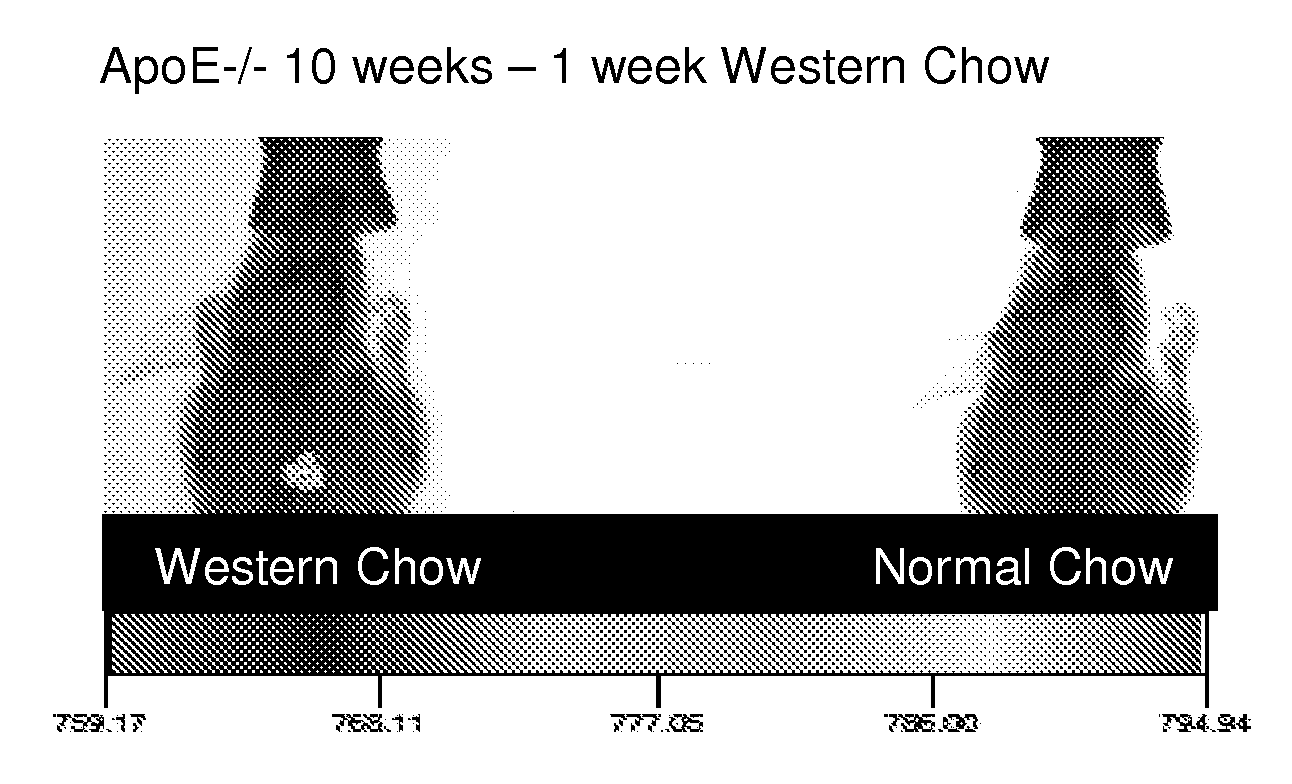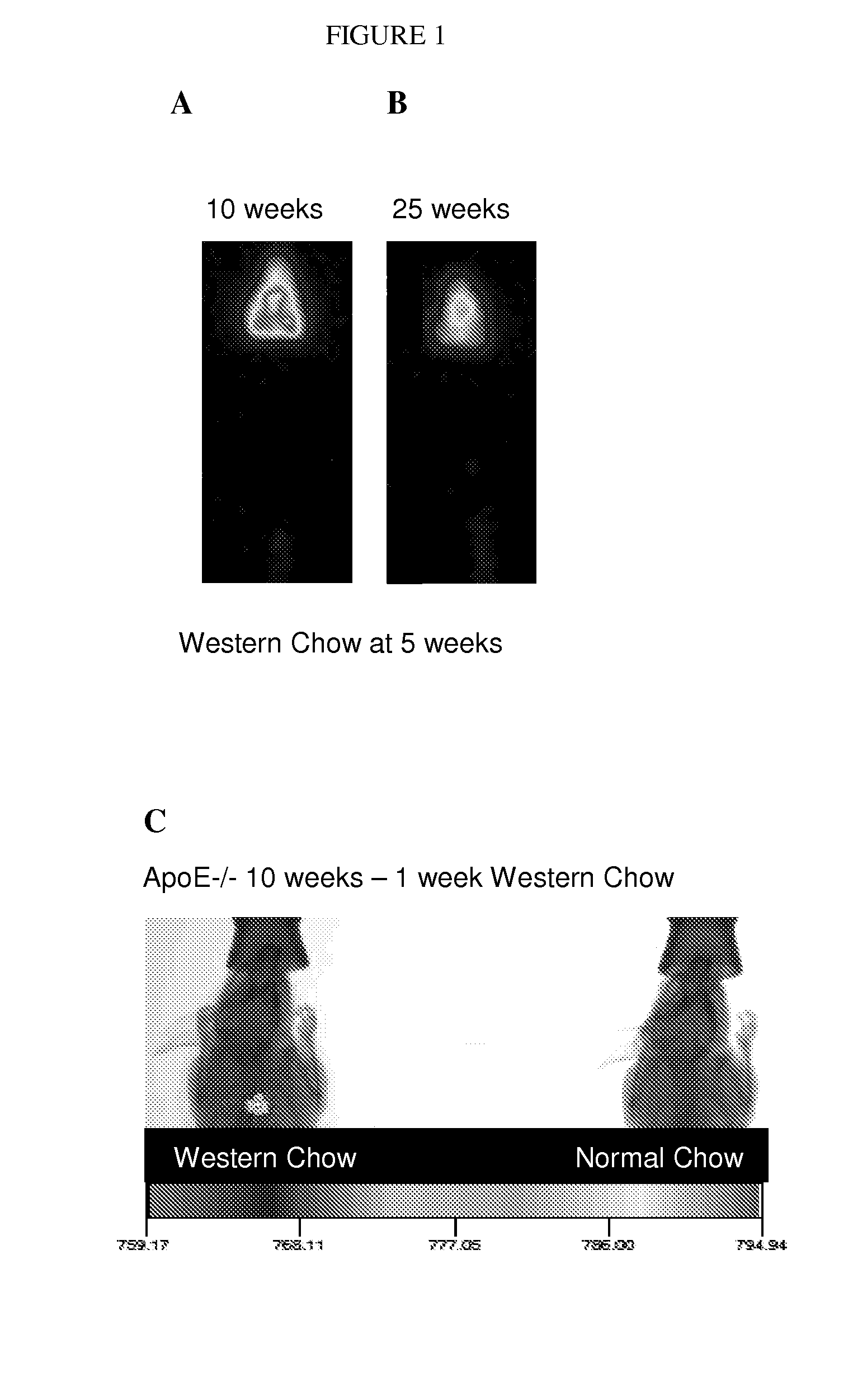Method for early imaging of atherosclerosis
- Summary
- Abstract
- Description
- Claims
- Application Information
AI Technical Summary
Benefits of technology
Problems solved by technology
Method used
Image
Examples
example 1
Preparation of EC20-99mTc
[0196]EC20-99mTc was prepared as described (Leamon et al., Bioconjug Chem, 2002, 13(6): 1200-10; incorporated herein by reference). Vials containing lyophilized EC20 were heated at 100° C. for 5 min, after which two mL of a 925 MBq / mL solution of sodium pertechnetate (Cardinal Health) was added and the vial was heated for an additional 15 min. After dilution with the desired volume of saline, mice were injected i.p. with either 400 μL of imaging agent (18.5 MBq, ˜250 nmoles / Kg of EC20) or the same volume of imaging agent supplemented with 100-fold molar excess of free folic acid (to compete for unoccupied folate receptors). Unbound EC20-99mTc was allowed to clear from the tissues for a period of four hours prior to imaging.
example 2
Animals—Induction of Atherosclerosis
[0197]ApoE− / − breeding trios (Jackson Laboratories) were maintained in a temperature- and humidity-controlled room on a 12 hour dark-light cycle. Female mice were weaned at 3 weeks of age and maintained on either normal rodent chow or transferred at five weeks of age to a Western diet consisting of 2% cholesterol, and 21.2% fat (Harlan-Teklad), as indicated above.
[0198]ApoE− / − mice were transferred to a high fat / cholesterol diet (Western Diet) for study—Harlan-Teklad TD.88137. ApoE− / − mice represent a well-known animal model for atherosclerosis. Unless otherwise indicated, mice were kept until 31 weeks on the diet. For example, five week old ApoE− / − mice were transferred and fed the Western Diet for 26 weeks. At different time points after transferring to the Western Diet mice were imaged using a KODAK Imaging Station In Vivo FX.
example 3
Imaging
[0199]EC20-99mTc was prepared as described above. Animals were allowed to clear for a period of 4 hours prior to imaging. Animals were either anesthetized with 3 to 4% isoflurane or euthanized for the imaging procedure. Images were taken in a KODAK Imaging Station In Vivo FX using the following settings. Image acquisition and ROI analyses were performed using KODAK Molecular Imaging software v. 4.5 (Carestream Molecular Imaging).
[0200]White Light Imaging:[0201]1. f-stop—22[0202]2. FOV—200×200 mm[0203]3. Emission—White[0204]4. Excitation—Open[0205]5. Exposure time—0.05 seconds[0206]6. Focus—7 mm
[0207]Radioimaging:[0208]1. f-stop—0[0209]2. FOV—200×200 mm[0210]3. Emission—Black[0211]4. Excitation—Open[0212]5. Exposure time—60 seconds[0213]6. Focus—7 mm[0214]7. Radioisotopic phosphor screen
[0215]X-Ray Imaging:[0216]1. f-stop—4[0217]2. FOV—200×200 mm[0218]3. Emission—Black[0219]4. Excitation—Open[0220]5. Exposure time—55 seconds[0221]6. Focus—7 mm[0222]7. Radiographic phosphor scr...
PUM
| Property | Measurement | Unit |
|---|---|---|
| Fraction | aaaaa | aaaaa |
| Fraction | aaaaa | aaaaa |
| Light | aaaaa | aaaaa |
Abstract
Description
Claims
Application Information
 Login to View More
Login to View More - R&D
- Intellectual Property
- Life Sciences
- Materials
- Tech Scout
- Unparalleled Data Quality
- Higher Quality Content
- 60% Fewer Hallucinations
Browse by: Latest US Patents, China's latest patents, Technical Efficacy Thesaurus, Application Domain, Technology Topic, Popular Technical Reports.
© 2025 PatSnap. All rights reserved.Legal|Privacy policy|Modern Slavery Act Transparency Statement|Sitemap|About US| Contact US: help@patsnap.com



